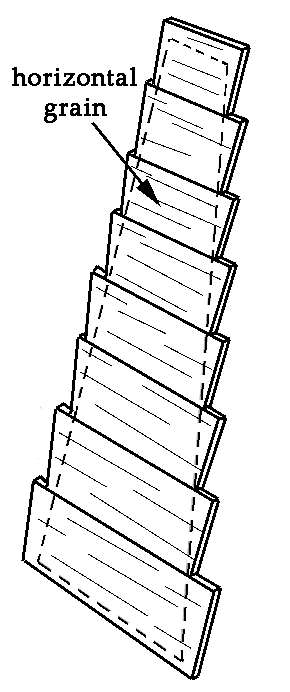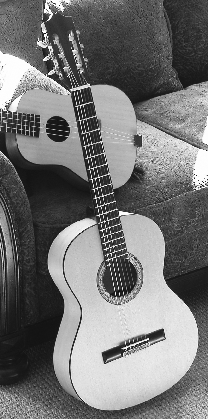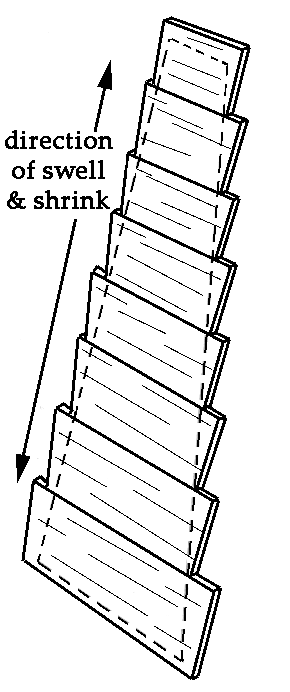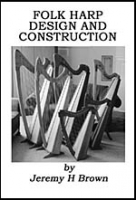Musicmakers Blog
Harp Soundboards: Plywood vs Solid Wood
Learn about the pros and cons of plywood and solid wood soundboards for harps.
The following is an excerpt from Chapter Four of Jerry Brown’s book on harp making, Folk Harp Design and Construction. The entire 150-page manual is in print in a 3-ring binder or as a downloadable PDF file.
The Great Plywood Debate: Laminated -vs- Solid Soundboards
There has been rather heated discussion over the years on the topic of soundboard composition. Should it be, as the purists argue, quarter-sawn solid spruce, or could the instrument actually be improved by using a modern material such as laminated wood? I will attempt to argue both sides of this debate as completely and convincingly as I can, leaving the reader to decide which way to proceed.
Much of this material has been summarized from a series of emails on the Internet Harplist over the years. I want to acknowledge those who have participated in this debate: Howard Bryan, Dan Cady, Al Carruth, Maren Leyla Cooke, Pat Dougal, David Drain, Jason Eyster, Glenn Hill, Rick Kemper, Tim McCurdy, Eliot Moss, Robert Mouland, Mike Parker, Dr. Douglas Peterson, and Betty Truitt. They may see some of their words and phrases printed in this chapter.
I hope this detailed presentation is worth the price of the book for some readers. But beware. Put on your waders. There may be some balderdash on each side of this debate!
The Case for Solid Spruce Soundboards
Basically, the best acoustic stringed instruments of any kind are those made with the highest quality solid spruce soundboards. The finest violins, cellos, guitars, etc. are all built with spruce soundboards. So it would be a compromise to entertain the thought of using anything but quarter-sawn old-growth spruce for the soundboard of a fine harp.
Musical vibrations (sound waves) are passed through the wood along the grain lines. The heavy winter growth rings give a quick response and a bright edge to the sound. The softer summer growth rings add a more mellow quality sound which, when combined with the brightness of the hard grain lines, yields the unmistakable richness of tone color that musicians look for in any instrument of value.
Solid spruce also tends to improve in sound with age. As the cell walls dry out further over time, they become more rigid and firm, and thus more responsive to string vibrations. This is why vintage guitars and old-world violins are such prized possessions. This tonal improvement is assisted by the application of nitro-cellulose lacquer finish (or mysterious old-world varnish) which continues to harden for years and becomes crystalline with age, adding to the brilliance of sound.

The process of making a high quality spruce board involves selecting fine grain spruce, resawing it to slightly over 1/4” thickness, and edge-gluing it together in short boards to achieve the size of soundboard needed for the harp. Once glued, the board is tapered from about 1/4” thickness at the bottom (bass end) to 1/8” thickness at the top (treble end). Ideally, this tapering is not “flat” but rounded (slightly convex) to maintain a full body in the mid-section. Likewise, the board is also tapered from the mid-line out to the edges, by reducing the thickness about 20 percent along the sides. This tapering gives the board more flexibility to vibrate freely.
Experienced builders then store their spruce soundboards in a “dry box” to make sure the wood has the lowest moisture content (under 7 percent moisture) it will ever have. Installing the board when it is at its driest state helps ensure against further shrinkage from climate changes. It does not hurt the board to expand with humidity, but further shrinkage can cause cracks along the grain lines or glue seams.
A quality spruce soundboard can be “tuned” before it is ever installed. This is accomplished by the “tap test”, a long tradition of listening to the sound of the board when tapping it with one’s knuckle. The low pitched tone emitted can be adjusted up or down by further thinning the board in various places, as a wooden xylophone key would be tuned.
Serious builders do not use plywood for soundboards. It is cheap material and does not generate the high quality sound desired by good musicians. You cannot taper it without sanding through the thin veneers. Consider how plywood is made: The log is soaked and boiled and peeled at high speed. The peelings (veneers) are then dried quickly before being glued together under high pressure and heat again. The end of all this ripping and tearing at the cell walls of the plant results in a material that, under a microscope, barely resembles wood any more.
Plywood is made with each layer having the grain lines running at 90 degrees to the adjacent layers. Sound waves do not travel well through these criss-crossing grain lines. Plywood also has a film of glue between each layer, and that further inhibits the sound waves from flowing naturally and smoothly through the material. And finally, the glue essentially “freezes” the wood into a static condition so it will never mellow and mature over time to yield a better sound.
Furthermore, the glue in plywood is likely to break down over time, both from repeated seasonal humidity cycles, as well as from all the vibrations generated from playing the instrument. These factors will cause de-lamination, buzzing inside the layers, and eventual failure of the plywood.
A properly prepared spruce soundboard, on the other hand, is a great deal stronger than plywood, and it will last much longer. Although it takes a great deal more time and craftsmanship to make a solid soundboard, it is well worth the effort. Do it right, and you will get a harp that sounds wonderful! Don’t use plywood unless you just can’t handle the job of resawing, book-matching, gluing, tapering, and sculpting a real wood soundboard.
“Old harp-makers never die. They just de-laminate!”
The Case for Laminated Soundboards
Traditions are good things to go by in many cases, but should we disregard scientific advances along the way? If harp-makers of the 19th century had been able to laminate thin layers of wood together for soundboards, we might have 100-year-old harps that are still playable today without having to be completely re-built. Sadly, however, that is not the case.

Harps are completely different instruments from violins, cellos and guitars. Consider that a 30-string harp has 5 times the number of strings, and 5 times the total tension of a steel string guitar. What is more, that string tension is pulling upwards at about a 30 degree angle to the soundboard on a harp, whereas it is pulling exactly parallel (0 degrees) to the soundboard of a guitar. And on a violin, the string tension is actually pushing down against the soundboard. Totally different stresses and dynamics.
Harps also lack the intricate inner bracing found on guitar soundboards. These factors make the harp a unique acoustical challenge, and they negate many of the comparisons used by proponents of solid wood soundboards. Harps and violins are as dissimilar as apples and oranges.
If we wish to make comparisons with other instruments, however, let us consider what physics tells us about sound waves in wood: they travel along the length of the grain of wood roughly four times faster than they travel across the width of the grain. That is why guitars and violins are built with the soundboard grain running the long way on the body of the instrument -- to take advantage of the way sound vibrates in the wood. When building a harp with solid wood, however, one must orient the grain horizontally for strength, and this effectively negates the advantage of having solid wood. The vibrations have only short lengths of grain to travel.
The most common problem with harps made with solid spruce soundboards is that the wood is left too thick to vibrate well. Thin it down to where it sounds good, and you are flirting with the danger of failure. One old adage says, “a harp always sounds best just before it breaks.” It is a delicate and risky exercise to attempt to get the best sound by approaching that limit too closely.
Another serious problem facing the solid soundboard builder is the issue of expansion and contraction due to humidity changes. Solid wood swells and shrinks across the grain lines quite dramatically from one season to another, especially in the northern climes where humidity often fluctuates from nearly 100 percent in the summer to less than 20 percent in the winter. Just as a new pair of pants will shrink in the clothes drier, a solid wood panel will also contract as it dries.
This type of shrinkage causes cracks to appear when the humidity is low because the ends of the soundboard are held firmly to the frame, and something has to give. This is the reason that cheap wood products from Third World countries often fall apart when imported to North America. Our climate is hard on wood. If a 50" long solid soundboard shrinks by even one percent from summer to winter, it will move a half inch!
Needless to say, most solid soundboard builders become very careful with humidity controls in their workshops. They also tend to emphasize humidity control to their customers, causing harpists to get very nervous about taking their instruments out of the house, especially in dry climates.
Laminated wood, however, experiences very little expansion and contraction from humidity changes because each layer of thin wood has the grain direction going in opposite directions. That is the "modern miracle", if you will, of plywood. And that is a great relief to the harp-maker because it allows him/her to make instruments that hold up in any climate. Wouldn’t it be nice to tell your customer that humidity control is not necessary for preserving one of your harps?

As for quality sound, an important concept overlooked by solid wood purists is that a harp soundboard operates much like a speaker membrane housed in a well-designed cabinet. The speaker membrane itself is just a thin composite material responding to impulses from an electromagnet mounted to the center of the membrane. There is no wood grain involved here. The important thing is to use a material for that membrane that pumps out the sound efficiently. The upward pull of strings on a harp soundboard replicates the pulsing action of an electromagnet on a speaker membrane.
The best way to achieve a membrane that is thin enough to pump out good sound, yet strong enough to withstand the string tension of a harp, is to use laminated material. Tapering is easy because you can “read” the thickness by how many layers of veneer you sand through. Don’t think of a laminated harp soundboard, however, in terms of the plywood one finds at a local lumber yard. Quality laminates are made with quality veneers all the way through -- no junk cores, no voids.
Truth be told, even some harps boasting "solid" soundboards actually have a layer of cross-grain veneer on either the front or the back (inside) of the soundboard. Builders have gotten tired of repairing cracked spruce fronts, so they add that layer to help stabilize the thicker solid wood. Some companies use fancy veneers (such as koa, curly maple, etc) on the front of the soundboard for decoration, and that also helps to deter cracks.
Admittedly, there are varying grades of laminated material to choose from. Three-ply Baltic Birch, for example, is quite inexpensive and fairly easy to find, but it does not hold up well over time. The best plywood available to date is Aircraft Birch, imported from Finland. The 3 millimeter material (1/8” thick) has 6 layers of thin birch veneers making up the total thickness. This material is virtually indestructible. You can find small pieces of it in hobby shops for model airplane building. Larger sheets, however, are harder to locate, often requiring a significant minimum order.
Yes, Aircraft Birch is much heavier (more dense) than spruce. That should make it vibrate poorly, right? Wrong. A physicist will tell you that you get a longer ring from a hardwood soundboard than from a softwood. What happens to sound waves in soft wood is that it decays more quickly because of the softness of the fiber. A hard fiber continues to vibrate longer because the vibrations are not absorbed so quickly.
The criticism about laminated soundboards failing or de-laminating over time is based on lower quality laminates, such as 3-ply material. Modern adhesives are stronger than the wood itself, and they are designed to last indefinitely. That’s why contractors build large buildings with laminated beams.
The claim that plywood soundboards will not improve and mature with age is silly. Why wait for a harp to mellow out, when you can have great sound right away?
Many successful harp makers have converted over to some sort of laminated soundboards in the past 10 years, partly because they got tired of repairing cracked solid spruce. These builders (better yet, their customers) will tell you that the newer instruments have not suffered in tonality by changing over to some sort of laminated material. Most harpists agree that the sound and performance of folk harps has improved over the years, rather than declined, and this positive trend reflects the growing utilization of laminated soundboards.
“Old harp-makers don’t de-laminate. They just need a little sprucing up!”
So there you have it. I hope I have presented both sides of the debate fairly, and I hope you are well enough informed to begin the process of making your own high quality soundboards.

Want to read more? The entire 150-page manual is in print in a 3-ring binder or as a downloadable PDF file. Buy your copy today.
